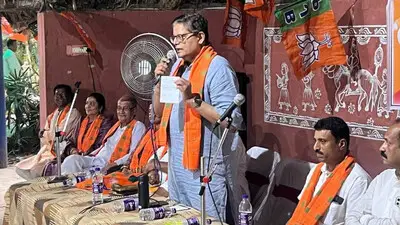Recommended Stories
Hatanaka, showcases Nihonga, an ancient Japanese fine art form which uses traditional colours ground from various stones and natural materials instead of chemical pigments in vogue currently.
"All over the world, the way people paint is changing. Nowadays, less and less artists are using natural ingredients and instead resorting to readymade paints and colours. The beautiful vivid colours made from stones and earth that are products of nature have their own tales to tell," the artist told PTI in an interview.
Carbon black, mineral pigments like azurite and agate and other natural pigments are what Hatanaka uses like all other traditional painters of this form. The resulting work is flat panelled with minimum or absolutely no layering at all.
"I don't like layering. I believe that painting should reflect the look of nature without any shading. That is why it is essential to use sophisticated techniques to create vivid
hues to recapture the beauty of nature," says the artist who is also impressed with traditional Indian painting techniques.
Although he has been coming to India from the year 1974 almost every year and has spend "almost 4 years" of total time in the country and has great affinity to Indian textiles and paintings, the current exhibition is his first here.
"I love India, the land of the Buddha and in this exhibition have included Gandhi and Mother Teresa. The basic concept is peace," says the artist who has picked up a smattering of hindi over the years.
The Kyoto based Hatanaka says he dislikes the current trend where artists resort to chemical pigments. Traditionally artists have used minerals, shells corals and even semi precious stones. The raw materials are manually powdered into gradations ranging from fine to sandy textures and each of the resulting pigments can reflect and absorb light in a different way.
"I don't like the current trend of modern paintings which does not reflect the true nature of paintings. I admire symbolic paintings especially the large Indian paintings and
the Mughal style of miniatures," says the artist who has published two books on Indian paintings.
He admires works by Indian artists such as Jogen Chowdury and Ram Kumar and is interested in the textiles of India. "Purana kapda (old clothes), embroidery and weaving techniques from Indian fascinate me," says the artist who has travelled all over India.
The professor of art, who has been painting for the last 50 years and who has exhibited globally says that in the current difficult economic times people are living in, there
is scope for a better understanding of traditional techniques of art.
"Art enriches and elevates people. This is why art must be a reflection of the senses of sight, hearing and touch all five senses. It is exactly the same for paintings. A
painting is a dialogue between the artist and those who seek to appreciate the emotions that the painting represents. I am delighted to present this exhibition and sincerely hope that it will have a lasting impact on the modern art of India," says Hatanaka.
The exhibition that runs till October 31 was inaugurated by Culture Minister Kumari Selja and is hosted by Ranbaxy.












